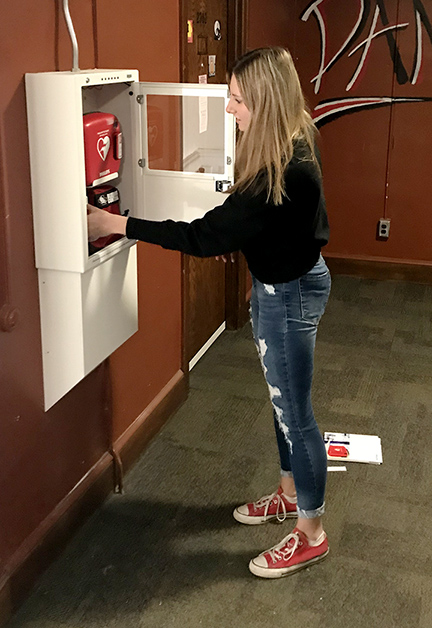HEART HEALTH MONTH: Student Request Leads to New AEDs in Residence Halls
February 21, 2023It started with an observation and a question. The end result could help save a life.
Addison Salski, an Iowa State student with a heart condition, didn’t have an automated external defibrillator (AED) near her room in Birch Hall. “I’m always looking around to see where they are at –it really catches my attention,” she said. “I’ve walked through (Birch) for months and never really saw one anywhere. This building probably isn’t the only one like that.”
Salski is a member of the President Leadership Class. At a meeting last December, she brought up her concern. “We talk about how to benefit the community and what we would change on campus and that’s how this came up, she said. “Can anyone raise your hand and tell me if they have seen an AED in their dorm – none of them could.”
President Wintersteen promptly connected her with staff from the Department of Residence (DOR) and the Department of Environmental Health and Safety (EH&S). After evaluating other locations with long travel distances, it was decided to add eight new AEDs in other locations to improve AED accessibility in residence halls. The first of which was installed in Salski’s residence hall, one floor below her room, on Wednesday, Feb. 15. Salski had the honor of placing the new AED in the cabinet.

“I didn’t think anything would come out of it,” she said. To physically put it in — WOW — something that I’m really passionate about, I’m making a difference and it’s only freshman year.”
“The health and safety of our residents is paramount. We greatly appreciate their active participation in maintaining and improving life safety in the residence halls,” said Greg Cross, Assistant Director for Safety Programs for Campus Life. “Addison raised a concern, and DOR and EH&S collaborated to quickly resolve the issue. I want to thank all involved for their hard work and dedication.”
First of Eight New AEDs
“When AEDs were first added to residence halls in 2017, they were placed near hall desk for familiarity,” said Alex Wiley, a fire and life safety specialist in EH&S. “While this was a good start, could still be a long distance away, like in Addison’s case.”
The DOR was able to purchase the new AEDS. The remaining seven will be placed will be placed once the cabinets have been hooked up to the campus system. New locations include Maple, Willow, Larch, Barton and Freeman halls. “It’s really cool to get this done quickly and take advantage of the moment,” said Wiley.
American Heart Month
February is American Heart Month, a time dedicated to raising awareness of heart conditions and heart health. Salksi has been doing that her whole life.
“Heart health is a topic for everyone, even if they are not diagnosed with a heart condition,” Salksi said. “Knowing how to use an AED, where the nearest one is, and why it is important are topics that need to be talked about more.”
At about the age of two, Salski was diagnosed with idiopathic ventricular tachycardia, which causes a rapid heart rate that, if sustained, may lead to serious problems like fainting, loss of consciousness, or cardiac arrest. It was necessary for her family to obtain an AED, but her parents quickly realized the difficulty of doing so. Insurance plans don’t cover AEDs, which can cost up to $1,500. Salski’s parents saw this as an opportunity to help other families facing similar challenges.
“I didn’t think anything would come out of it … To physically put it in — WOW — something that I’m really passionate about, I’m making a difference and it’s only freshman year.”
Addison Salski
In 2013, Salski’s parents founded Big Dreams for Little Hearts, a non-profit organization that raises money to donate AEDs to children with heart conditions, so that they could help provide peace of mind to other families. Now, Salski spreads that same mission on Iowa State’s campus.
“I knew that someday a student could show up just like me, hoping for that sense of safety and security,” said Salski, who serves as president of Big Dreams for Little Hearts’ board. “I wanted to provide that safety for any university student just as Big Dreams has for over 30 families.”
Salski expressed that having an AED in her residence hall won’t just benefit her in an emergency. An AED can be used in any situation where someone experiences cardiac arrest, which is “just as important for people of any age, with or without a health problem,” she said.
Salski encouraged students who want to improve health and safety on campus that “there is nothing too big, or impossible even, on such a large campus…Iowa State is open and welcoming to new ideas, and when it comes to the health and safety of students, they are more than willing to listen.”
